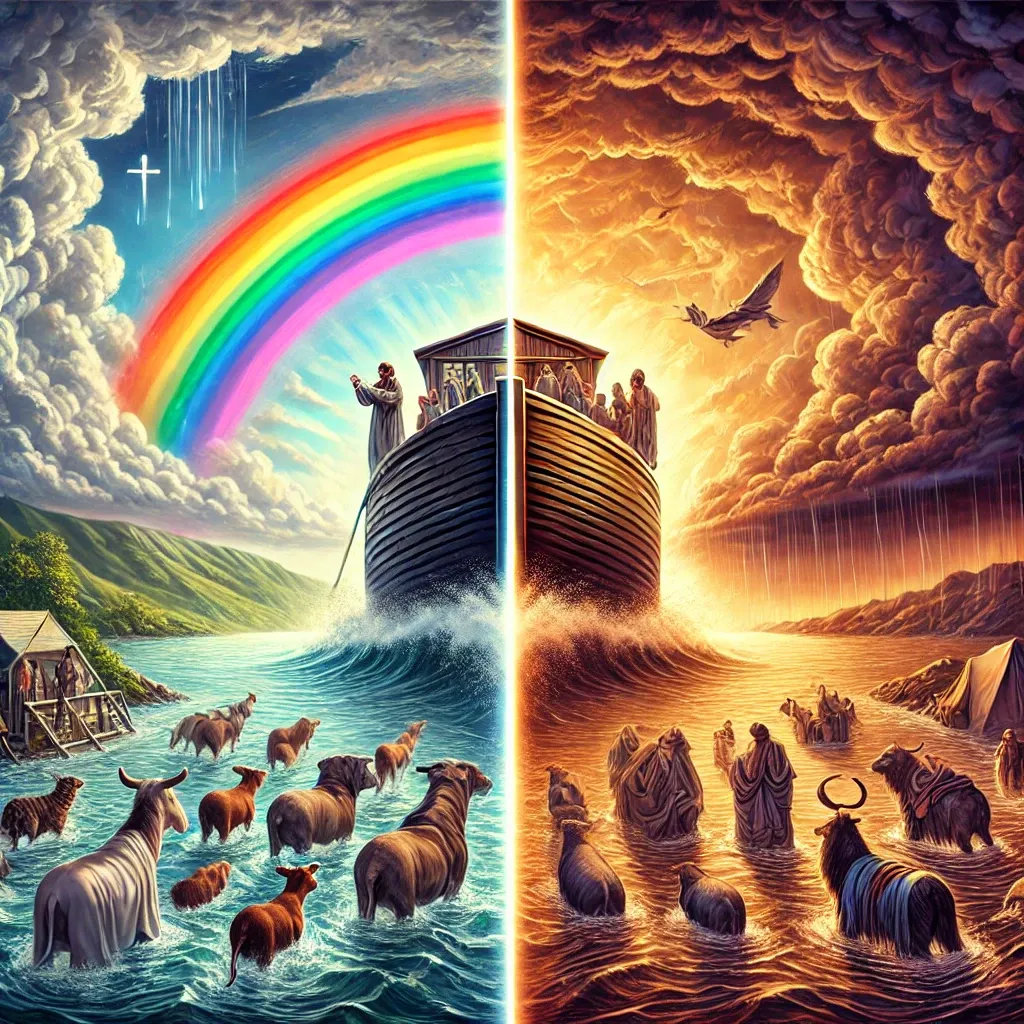

By Dr. Tim. Orr
What does a global flood say about the character of God? For many, the story of Noah evokes childhood images of animals boarding an ark two by two—but beneath that familiar imagery lies a profound theological divide. As I reflect on this narrative today, I realize it tells two very different stories depending on whether you read it through the lens of Christianity or Islam. Maybe you did, too. Something was mesmerizing about the image of animals boarding an enormous boat while the rain poured and the waters rose. But as the years passed, I started to see something deeper in that story—something that had less to do with giraffes and elephants and more with grace, judgment, and the human heart.
As someone who’s spent years studying Christian and Islamic theology, I’ve realized just how profound the Noah story really is. The Bible and the Qur’an tell it—but what they mean by it is very different. That difference says a lot about how each tradition sees God, humanity, and salvation. Let’s take a deeper look. In the sections that follow, we’ll explore five key elements of the Noah narrative through both a Christian and Islamic lens: Noah’s righteousness, the meaning of the flood, the symbolism of the ark, the role of covenant, and what each story ultimately reveals about the character of God.
The Man: Noah’s Righteousness—Faith or Function?
In both the Bible and the Qur’an, Noah stands out as a righteous man in a corrupt generation. But what makes him righteous?
In the Bible, it’s clear that Noah’s righteousness is tied to faith. Genesis 6:8 says, “But Noah found favor in the eyes of the Lord.” The Hebrew word for “favor” implies grace—unearned, unmerited kindness from God. Noah didn’t earn his righteousness by being morally perfect; he received it by trusting God. Hebrews 11:7 confirms this, saying that Noah “became heir of the righteousness that is in keeping with faith” (Holy Bible, New International Version [NIV], 2011).
There’s something deeply humbling about that. In Christian theology, this distinction between grace and works is crucial—grace refers to God’s unearned favor given freely, while works refer to human effort to earn righteousness. Noah didn’t save himself by good behavior; he was saved because he trusted God’s promise. That’s a profound difference from a worldview where righteousness results from moral performance alone. It’s like being offered a lifeboat when the storm hits—not because you swam better than others, but because someone reached out to pull you in. That’s the tone of Noah’s righteousness in Scripture. It reflects grace received, not just moral effort.
In Islam, by contrast, Noah is honored as one of the first messengers sent by God. The Qur’an presents him in functional terms—a prophet with a mission. “Indeed, We sent Noah to his people, [saying], 'Warn your people before there comes to them a painful punishment'” (Qur’an 71:1-2, Sahih International, n.d.). Noah’s righteousness is grounded in his prophetic role and unwavering obedience, not a relational faith response. He is faithful in proclaiming tawhid (the oneness of God), and that faithfulness defines his virtue.
The difference is subtle but significant—yet it sets the tone for the entire comparison. This foundational theological divergence shapes how each tradition interprets Noah’s role and the broader nature of salvation, obedience, and divine relationship. One portrays Noah as a man clinging to grace, while the other portrays him as a man delivering a message.
The Flood: Cosmic Reset or Moral Deterrent?
In both traditions, the flood is a response to human corruption. But its meaning unfolds in very different directions.
In Genesis, the flood is God’s judgment—but it’s also a turning point in the redemptive storyline. God doesn’t merely wipe the slate clean; He preserves a remnant and establishes a covenant afterward. “Never again will there be a flood to destroy the earth,” God promises in Genesis 9:11, sealing that promise with a rainbow—a visible, enduring reminder of divine mercy (Holy Bible, NIV, 2011).
What’s striking—especially when contrasted with the Islamic narrative—is how the biblical account doesn’t end with destruction but transitions into hope. The flood becomes a backdrop for God’s long-term commitment to His creation. It’s not just about what God does against evil; it’s about what God plans to do for His world. In this sense, the rainbow becomes more than a symbol of nature—it’s a signpost pointing to God’s redemptive purposes.
The New Testament draws a straight line from Noah to Christ. The Apostle Peter, reflecting on the flood, writes, “This water symbolizes baptism that now saves you also… by the resurrection of Jesus Christ” (1 Peter 3:21, Holy Bible, NIV, 2011). In Christian theology, the ark becomes a picture of Christ Himself—the One we find refuge from judgment. This approach is rooted in a theological concept called typology, where people, events, or objects in the Old Testament are seen as foreshadowing or symbolizing greater spiritual realities fulfilled in the New Testament (Beale, 2011).
The Qur’anic account tells the story differently, reflecting broader Islamic theology where divine justice is emphasized over covenantal continuity. In Islam, narratives like Noah’s serve to illustrate Allah’s authority and the consequences of rejecting divine guidance rather than being part of an unfolding redemptive storyline. This fits a recurring pattern in the Qur’an, where prophetic messages end with judgment and vindication rather than restoration and covenantal development. The flood in Islam is a divine punishment for disobedience. Noah preaches, warns, and pleads—but his people reject him, so Allah commands him to build an ark. The emphasis falls not on grace or covenant but on obedience and consequence. “Then We opened the gates of the heaven with rain pouring down” (Qur’an 54:11, Sahih International, n.d.). There is no covenant after the flood, no rainbow in the sky, and no ongoing redemptive thread. The story ends with divine justice served and the prophet vindicated.
The Ark: A Symbol of Christ or a Vehicle of Escape?
In Christian thought, the ark itself carries powerful theological meaning. It’s not just a boat—it’s a symbol of salvation. In the same way that Noah and his family were saved by entering the ark, Christians are saved by entering Christ. It’s a compelling image: the ark bears the brunt of the storm so those inside can be safe. That’s the gospel in miniature.
I remember explaining this to a friend over coffee once. He asked, “Why does the ark matter so much to Christians?” I said, “Because it foreshadows the cross. Like Noah entered the ark and was saved, we enter Christ and are sheltered from judgment.”
That’s a deeply personal reality for many of us. In seasons when the storms of life rage—grief, guilt, fear—it’s not our performance that saves us. It’s the One who bears the storm on our behalf.
In Islam, the ark doesn’t carry symbolic weight. It is, quite literally, a vehicle of escape. There’s no theological typology attached to it. The Qur’an records, “We carried him on a [ship] of planks and nails” (Qur’an 54:13, Sahih International, n.d.). The ark serves a function, not a redemptive metaphor. It represents survival through obedience, not salvation through grace.
The Covenant: Redemption Story or Historical Episode?
After the flood, God makes a covenant with Noah and all living creatures (Genesis 9:9-17, Holy Bible, NIV, 2011). That covenant is a foundational part of biblical theology. It’s not just about a promise never to send another flood; it’s part of a sequence of divine covenants that shape the arc of salvation history. From Noah to Abraham to Moses to David, the covenantal structure moves forward until it culminates in Jesus—the mediator of a new and better covenant (Hebrews 8:6, Holy Bible, NIV, 2011).
Theologians call this “covenantal progression”—a term that refers to the unfolding sequence of divine covenants throughout Scripture, each building upon the last to move God’s redemptive plan forward. Each covenant is a thread in God’s long-term plan to restore what was lost in Eden and prepare humanity for redemption through Christ (Wright, 2006).
In the Islamic narrative, this covenantal theology is absent. The story of Noah concludes without a divine promise for the future. There is no new chapter pointing toward redemption—only a lesson about the consequences of rejecting God’s messengers. That reflects the broader Islamic theology where divine guidance is revealed in segments without the same redemptive continuity.
The Bigger Picture: God’s Character on Display
At the heart of this comparison is a question: What kind of God is revealed in each story?
In the Christian narrative, God is just—but also deeply relational. He judges evil, but He also preserves, redeems, and restores. The flood doesn’t have the final word—grace does. The ark doesn’t just protect from water—it prefigures Christ. The covenant doesn’t merely end the flood—it begins the journey toward salvation.
In the Islamic narrative, God’s justice is central. He is powerful, righteous, and utterly sovereign. The flood is a lesson in divine authority and human accountability. But the story ends there. There’s no ongoing pursuit, no hint of a coming Redeemer, no whisper of grace breaking in through judgment.
That difference speaks volumes—one story leads toward a Savior, the other toward submission. It shapes not only how we read Noah’s story but also how we understand our own.
Conclusion: Which Story Are You In?
When I first began to compare Noah's narratives in Christianity and Islam, I thought I was studying a shared story. But I came to realize I was looking at two different spiritual maps. One leads toward a Savior, the other toward submission. One is centered on redemption, the other on obedience.
Both stories tell us something about judgment. But only one tells us about rescue through grace.
Maybe today you feel like the floodwaters are rising in your life. What story are you living in—one shaped by obedience alone or anchored in grace and redemption? Perhaps it's time to ask: Have you found your ark? If so, the Christian story offers something more than survival—it provides salvation. And like Noah, you don’t need to be perfect to receive it. You need to step into the ark.
References
Beale, G. K. (2011). A New Testament biblical theology: The unfolding of the Old Testament in the New. Baker Academic.
Holy Bible, New International Version. (2011). Zondervan.
Sahih International. (n.d.). The Qur'an. https://quran.com
Wright, C. J. H. (2006). The Mission of God: Unlocking the Bible’s grand narrative. InterVarsity Press.
Who is Dr. Tim Orr?
Tim serves full-time with Crescent Project as the assistant director of the internship program and area coordinator, where he is also deeply involved in outreach across the UK. A scholar of Islam, Evangelical minister, conference speaker, and interfaith consultant, Tim brings over 30 years of experience in cross-cultural ministry. He holds six academic degrees, including a Doctor of Ministry from Liberty University and a Master’s in Islamic Studies from the Islamic College in London.
In addition to his ministry work, Tim is a research associate with the Congregations and Polarization Project at the Center for the Study of Religion and American Culture at Indiana University Indianapolis. His research interests include Islamic antisemitism, American Evangelicalism, and Islamic feminism. He has spoken at leading universities and mosques throughout the UK—including Oxford University, Imperial College London, and the University of Tehran—and has published widely in peer-reviewed Islamic academic journals. Tim is also the author of four books.
